Movies We Like
Handpicked By The Amoeba Staff
Films selected and reviewed by discerning movie buffs, television junkies, and documentary diehards (a.k.a. our staff).
Anatomy of a Murder
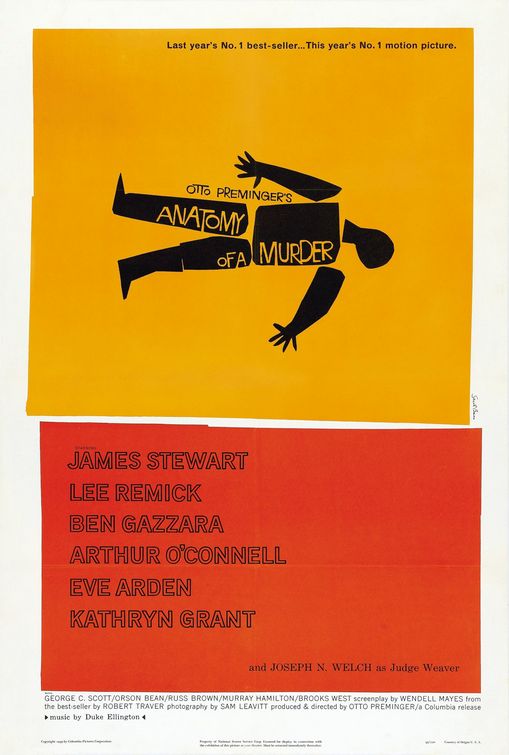 Director Otto Preminger seemed to look for controversial subjects all through his career but with his two hour and forty minute courtroom masterpiece Anatomy of a Murder, he might’ve gone farther than 1959 audiences could handle. The film is about a lawyer defending a man who’s accused of killing a guy who possibly raped his wife. If that wasn’t lurid enough for audiences, they especially got all angsty over a word that was repeated in the trial, that horrific word…. “panties” (you know, women’s underwear). For anyone who can get past such a lewd word, Anatomy of a Murder is very dense in detail, almost an epic in just exploring the small details of a legal case. And it’s still one of the best lawyer flicks ever.
Director Otto Preminger seemed to look for controversial subjects all through his career but with his two hour and forty minute courtroom masterpiece Anatomy of a Murder, he might’ve gone farther than 1959 audiences could handle. The film is about a lawyer defending a man who’s accused of killing a guy who possibly raped his wife. If that wasn’t lurid enough for audiences, they especially got all angsty over a word that was repeated in the trial, that horrific word…. “panties” (you know, women’s underwear). For anyone who can get past such a lewd word, Anatomy of a Murder is very dense in detail, almost an epic in just exploring the small details of a legal case. And it’s still one of the best lawyer flicks ever.
The film is loaded with talent on both sides of the camera including a famous title sequence by Saul Bass (Psycho) and a catchy score by Duke Ellington (strange since the film takes place in Michigan’s Upper Peninsula—not exactly a “jazzy” part of the country. Also, Duke appears in a cameo as well.) Michigan Supreme Court Justice John D. Voelker wrote the book based on a real life case; the script was shrewdly adapted by Wendell Mayes (The Poseidon Adventure, Death Wish). It’s also shot in cool black & white by the dependable cinematographer Sam Leavitt (A Star Is Born, Exodus, Major Dundee) and it was edited by another pro, Louis R. Loeffler (Laura, The Long Hot Summer). And of course director/producer, the Hungarian-born Preminger himself, was one of the big guns of his era, with a directing career going back to the Noir period (Laura, Whirlpool). Anatomy of a Murder was easily his best film but everything he did, no matter the overall quality, was always interesting.
Criminally Insane
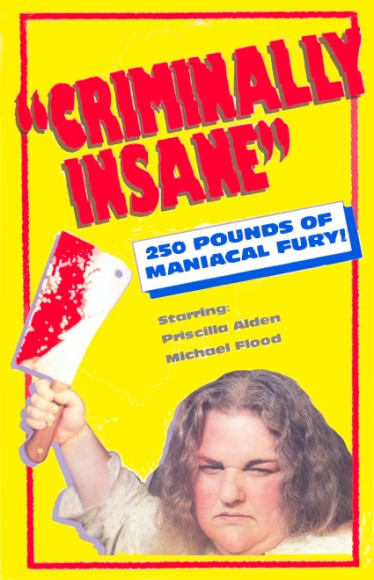 A special kind of applause should be granted to any actor/actress who can take on a role that in some form or another mocks their features, or worse, feeds into the stigmas they get from other people. For example, Camryn Manheim's performance in Happiness where she calls herself “fat” and “ugly” while slurping down ice cream, or Paul Reubens playing the ghost of a pervert in Todd Solondz's most recent film Life During Wartime. Criminally Insane marks the beginning of the short but interesting low-budget career for actress Priscilla Alden. The tagline of the film is “250 pounds of maniacal terror,” and Alden breathes life into the phrase with her pathetic, brutal, and sometimes comic portrayal of Ethel Janowski, also known as “Crazy Fat Ethel.”
A special kind of applause should be granted to any actor/actress who can take on a role that in some form or another mocks their features, or worse, feeds into the stigmas they get from other people. For example, Camryn Manheim's performance in Happiness where she calls herself “fat” and “ugly” while slurping down ice cream, or Paul Reubens playing the ghost of a pervert in Todd Solondz's most recent film Life During Wartime. Criminally Insane marks the beginning of the short but interesting low-budget career for actress Priscilla Alden. The tagline of the film is “250 pounds of maniacal terror,” and Alden breathes life into the phrase with her pathetic, brutal, and sometimes comic portrayal of Ethel Janowski, also known as “Crazy Fat Ethel.”
Janowski is an obese mental patient with whom you sympathize at first. The film opens with her shock therapy sessions, followed by her glaring at the camera while dressed in a straitjacket. We are then introduced to her grandmother (Jane Lambert), who speaks with her doctors about her progress and the possibility of taking her home. Ethel is released from the asylum and returns to a quiet San Francisco neighborhood with her grandmother. Once settled she dives into a bout of anti-Semitic slurs against her doctor, whom she claims was trying to starve her to death. Simultaneously she begins to stuff her face with a hearty breakfast: a dozen fried eggs, a whole slab of bacon, half a loaf of toasted bread, and milk. The scene is unnerving for two reasons: (1) watching Ethel in a close-up stuffing her face is uncomfortable and purposefully repulsive, and (2) you get the feeling that someone with that kind of insatiable appetite has more in common with a predatory beast than a human being with logical thoughts. There's also discomfort in the dialogue from the grandmother who is passively bullying her while she's eating—reciting the ol' “never too late to watch your figure” line.
Thundercrack!
It's fairly safe to say that those who consider themselves cineastes or cinefiles have a series of genres in which they feel quite knowledgeable. In retrospect, they often praise these films on the obvious basis that they think they're superior to other genres in many ways. A horror buff will scoff at the claim that classic dramas are unmatchable in terms of style and entertainment, and vice versa. The irony behind these arguments is that underneath every film is just a story—some fantastical and others quite plain. Film does not reflect life and human consciousness so much as it interprets these things and distorts them for the viewer. Everyone walks away with their own subjective thoughts because of a mirrored element, or lack of, which they can relate to. The magic is in the varied levels in which a film can affect a wide range of people. If there is any sense or weight to my claim here, you won't find a broader or more distorted film than Thundercrack!.
Rarely will a person like myself glorify or reference a film that is classified as smut. Perhaps it's because modern smut is lacking in something quite important: a story that can hold itself up without the exposure of genitals. Thundercrack!, written by and starring George Kuchar (1942–2011) and directed by his good friend (possible ex-lover) Curt McDowell (1945–1987), is a parody film like nothing you've ever seen and is now among my top 20 favorite movies. It pays homage to just about every genre, specifically horror, Noir, fantasy and comedy, and presents the viewer with something very extraordinary.
Stone Cold
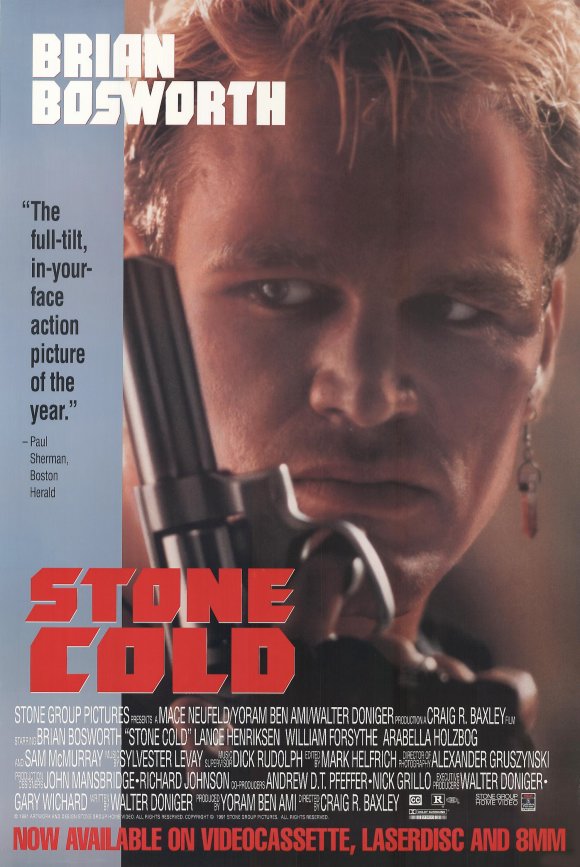 Like Romeo & Juliet before it, the basic premise of Stone Cold has been recycled dozens of times since its release (Point Break, Good Cops Don’t Cry, The Fast and the Furious). Does this sound familiar? A maverick cop goes undercover into a dangerous criminal underworld and, under the spell of the bad guy’s charismatic leader, maybe gets in a little too deep. Skipping the Actors Studio or some other pansy thespian training, Brian “The Boz” Bosworth learned his acting ropes on the NFL field. At one time he was a big football star; with his way-out mullet dos and crazy sunglasses he was a sorta steroid version of David Lee Roth.
Like Romeo & Juliet before it, the basic premise of Stone Cold has been recycled dozens of times since its release (Point Break, Good Cops Don’t Cry, The Fast and the Furious). Does this sound familiar? A maverick cop goes undercover into a dangerous criminal underworld and, under the spell of the bad guy’s charismatic leader, maybe gets in a little too deep. Skipping the Actors Studio or some other pansy thespian training, Brian “The Boz” Bosworth learned his acting ropes on the NFL field. At one time he was a big football star; with his way-out mullet dos and crazy sunglasses he was a sorta steroid version of David Lee Roth.
Joe Huff (Bosworth) is a loner cop who plays by his own rules. He’s stone cold, not just because he wears stonewash jeans, but also because underneath his long black dusters he’s fearless, with almost a death wish. After being blackmailed by a prick Fed (Sam McMurray), Huff is forced to infiltrate a tough, beer- drinking biker gang who've killed a judge and been involved in all kinds of naughty activity. No longer Huff, The Boz opts for the kickass undercover name Stone. To get to the big dog, Chains Cooper (Lance Henrikson), Huff has to get past his second-in-command, the psychotic Ice (William Forsythe). And as the formula goes, Chains, though a scary dude, starts to trust Huff, and even encourages his old lady, Nancy (Arabella Holzbog), to have a go at him, but his Lieutenant Ice smells a rat.
The Dead Zone
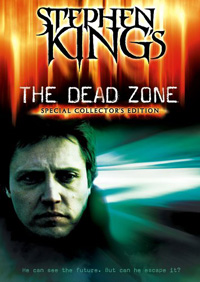 David Cronenberg. Stephen King. Christopher Walken. You need no other excuse to check out this movie other than the fact that it’s the one and only time that those three names shared credit space at the opening of a film; and at a time when they were all creatively at the top of their game as director, writer and actor respectively. The Dead Zone is based on King’s successful novel of the same name, adapted for the screen by Jeffrey Boam (with a polish by David Cronenberg) and stars Christopher Walken at a time just before he became the "go-to" eccentric character actor in just about everything.
David Cronenberg. Stephen King. Christopher Walken. You need no other excuse to check out this movie other than the fact that it’s the one and only time that those three names shared credit space at the opening of a film; and at a time when they were all creatively at the top of their game as director, writer and actor respectively. The Dead Zone is based on King’s successful novel of the same name, adapted for the screen by Jeffrey Boam (with a polish by David Cronenberg) and stars Christopher Walken at a time just before he became the "go-to" eccentric character actor in just about everything.
Walken plays Johnny Smith, a content school teacher who has a passion for his job, the admiration of his students and is engaged to the love of his life. But one fateful night, he’s involved in a terrible car accident that puts him in a coma. When he awakens, six years have passed, his limbs have suffered from atrophy, his job is gone and his fiance is now married to another man and a mother to a child that isn’t his. But he’s also awoken from his deep slumber with an unlikely gift; the gift of second sight. One mere touch and he’s able to not only see your past and present, but also see your future.
Bread & Roses
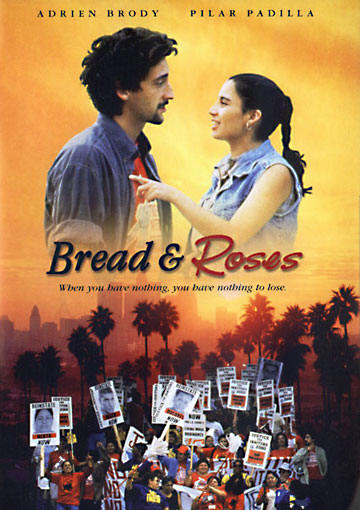 Once upon a time in Los Angeles, in the 1990s, the biggest labor strife to hit the town in fifty years was the janitor’s service union strike, a group made up of mostly legal and illegal immigrants from south of the border (giving it an especially underdog meaning). The great British “kitchen sink realism” director Ken Loach (Riff-Raff, The Wind That Shakes the Barley) came and made Bread &Roses—a very special film that uses the labor dispute as a backdrop and in doing so made one of the best films in years about both Los Angeles and the immigrant experience.
Once upon a time in Los Angeles, in the 1990s, the biggest labor strife to hit the town in fifty years was the janitor’s service union strike, a group made up of mostly legal and illegal immigrants from south of the border (giving it an especially underdog meaning). The great British “kitchen sink realism” director Ken Loach (Riff-Raff, The Wind That Shakes the Barley) came and made Bread &Roses—a very special film that uses the labor dispute as a backdrop and in doing so made one of the best films in years about both Los Angeles and the immigrant experience.
Looking for work, Maya (Pilar Padilla) sneaks into the country, joining her sister Rosa (Elpidia Carrillo) who is legal (married to an American). Eventually Maya gets work cleaning high-rise office buildings, but every corner she turns there seems to be someone wanting to exploit her and take advantage of her illegal status (both sexually and economically). After being befriended by labor activist Sam Shapiro (Adrien Brody), Maya eventually becomes a leader and helps to organize the union, becoming sort of a Mexican “Norma Rae.” This leads to complications with her sister, who doesn’t want to rock the boat and is already taking great chances boarding her.
Bereavement
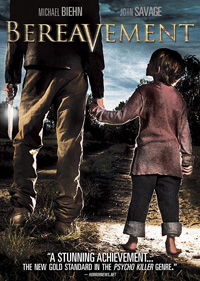 Let me cut right to the chase. Bereavement is a real-deal horror film in the sense that it depicts some of the most horrific things I’ve ever seen in a genre movie. But the nastiness is necessary and the payoff is earned in the delicate and capable hands of a skilled filmmaker/storyteller such as writer/director Stevan Mena. Yes, this film also acts as a prequel to Mena’s debut feature Malevolence, but it’s also a rare anomaly in the genre. It’s a film that strives to satisfy two different audiences; those that love the first film and want to learn the backstory that comes before the original. And then there are those who are simply walking into it blindly just wanting to see a new, original horror movie. In that regard, he succeeds at delivering what both audiences would want with Bereavement. The biggest difference between the two is that if you already know the previous feature, you kind of know where this story has to inevitably end in order to line-up with Malevolence; whereas newcomers will probably be shocked by the grim, dark descent that the story takes.
Let me cut right to the chase. Bereavement is a real-deal horror film in the sense that it depicts some of the most horrific things I’ve ever seen in a genre movie. But the nastiness is necessary and the payoff is earned in the delicate and capable hands of a skilled filmmaker/storyteller such as writer/director Stevan Mena. Yes, this film also acts as a prequel to Mena’s debut feature Malevolence, but it’s also a rare anomaly in the genre. It’s a film that strives to satisfy two different audiences; those that love the first film and want to learn the backstory that comes before the original. And then there are those who are simply walking into it blindly just wanting to see a new, original horror movie. In that regard, he succeeds at delivering what both audiences would want with Bereavement. The biggest difference between the two is that if you already know the previous feature, you kind of know where this story has to inevitably end in order to line-up with Malevolence; whereas newcomers will probably be shocked by the grim, dark descent that the story takes.
Bereavement opens pretty much the same way that Malevolence does; with the kidnapping of little Martin Bristol at the hands of deranged serial killer Graham Sutter. It then cuts 5 years later, and we follow Allison Miller (Alexandra Daddario), a young teen who is forced to move in with her uncle Jonathan (Michael Biehn) and his family after losing her parents in a car accident. She takes some solace in her budding new relationship with her neighbor William (Nolan Funk), whom her uncle doesn’t approve of. But William also has problems of his own. He struggles to care for his verbally abusive, invalid father with hopes of one day "getting outta this town." The great thing about the story arcs of both Allison and Martin is that they run concurrently and eventually collide. Much like Mena did with Malevolence, he’s again combining two genres in the same feature. For Malevolence, it was the action heist film that became a “slasher” movie. Here, it’s pretty much a serious, straightforward hardcore drama that eventually becomes a "slasher" flick.
Shane
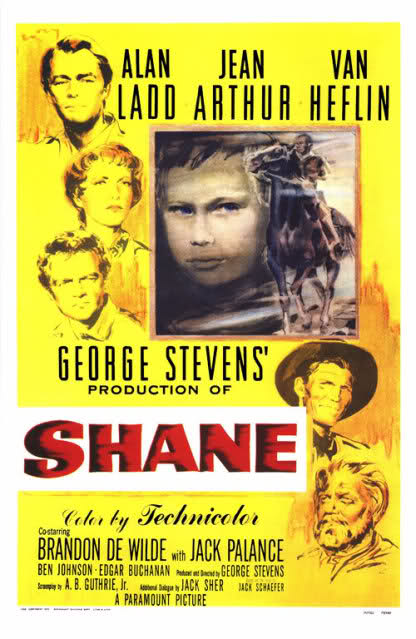 John Ford may have brought the Western out of the B-movie jungle and into the respected leagues (Stagecoach, My Darling Clementine, The Searchers, etc.), but George Stevens took the workman’s template and made it beautiful. With his masterpiece, Shane—maybe the greatest American Western of all time—he infused the genre with even more mythology than it already relied on. Shane is the film that influenced the Western Revisionists and Postmodernists more than any other; Sergio Leone and his Italian friends in the Spaghetti Western scene were all obsessed with Shane and it shows in their work. If the plot of Shane sounds familiar that’s because it’s been recycled dozens of times in everything from Westerns (Pale Rider) to post-apocalyptic junk (Steel Dawn). Shane may have more to say about the Hollywood myth and romanticism of violence, and more poetically, than any film before or since.
John Ford may have brought the Western out of the B-movie jungle and into the respected leagues (Stagecoach, My Darling Clementine, The Searchers, etc.), but George Stevens took the workman’s template and made it beautiful. With his masterpiece, Shane—maybe the greatest American Western of all time—he infused the genre with even more mythology than it already relied on. Shane is the film that influenced the Western Revisionists and Postmodernists more than any other; Sergio Leone and his Italian friends in the Spaghetti Western scene were all obsessed with Shane and it shows in their work. If the plot of Shane sounds familiar that’s because it’s been recycled dozens of times in everything from Westerns (Pale Rider) to post-apocalyptic junk (Steel Dawn). Shane may have more to say about the Hollywood myth and romanticism of violence, and more poetically, than any film before or since.
Based on the novel Shane by Jack Schaefer, the film is seen through the eyes of a young farm boy, Joey Starrett (Brandon De Wilde), in the settled territory of Wyoming. Life’s a struggle for his proud but modest parents, Joe (Van Heflin) and Marian (Jean Arthur). Besides the usual struggles against nature in the tough terrain, the area is owned by the ruthless baron, Rufus Ryker (Emile Meyer), who is trying to force the Starretts and the other local homesteaders off their land. When a drifter named Shane (Alan Ladd) shows up on horseback, the Starretts take him on as a ranch hand and he gets involved in the conflict between the wholesomely innocent homesteaders and the greedy Ryker and his posse of hired goons.
Paper Moon
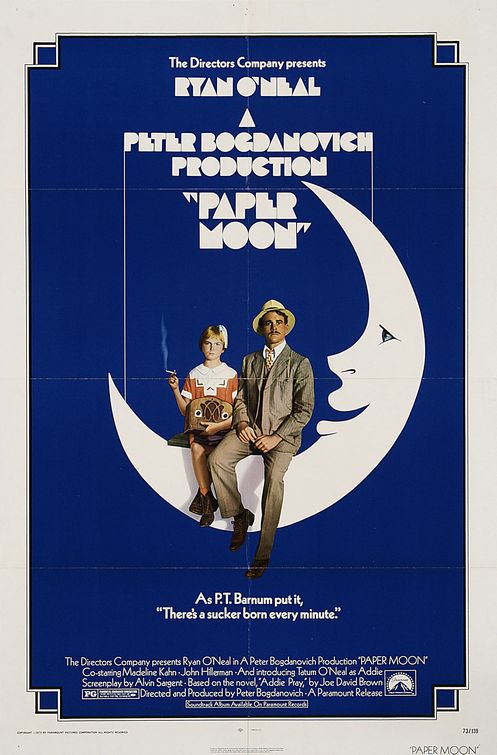 Along with The Sting, Paper Moon, made a few years earlier, may be the quintessential Depression-era conman film. But while The Sting, though terrific, was more of a gimmicky star vehicle, Paper Moon has even more heart than con. In the best role of his career, Ryan O’Neal (once upon a time he was actually a superstar) stars opposite his real-life daughter Tatum O’Neal. At just eight-years-old, she gives one of the most acclaimed child performances ever. Director Peter Bogdanovich was working at the peak of his powers, fresh off the brilliant The Last Picture Show and the popular What’s Up, Doc? He vividly recreates the flat, lonely landscapes of 1930s Kansas; shooting in beautiful black & white, the period detail is as good as any modern film has ever done.
Along with The Sting, Paper Moon, made a few years earlier, may be the quintessential Depression-era conman film. But while The Sting, though terrific, was more of a gimmicky star vehicle, Paper Moon has even more heart than con. In the best role of his career, Ryan O’Neal (once upon a time he was actually a superstar) stars opposite his real-life daughter Tatum O’Neal. At just eight-years-old, she gives one of the most acclaimed child performances ever. Director Peter Bogdanovich was working at the peak of his powers, fresh off the brilliant The Last Picture Show and the popular What’s Up, Doc? He vividly recreates the flat, lonely landscapes of 1930s Kansas; shooting in beautiful black & white, the period detail is as good as any modern film has ever done.
Paper Moon is based on the novel Addie Pray by Joe David Brown (Kings Go Forth), with the screenplay by Alvin Sargent, whose massive screenwriting career ranges from Ordinary People to the recent Spider-Man sequels. Moses Pray (Ryan) is a two-bit conman. He thinks he can make a buck when, after the funeral of a one-time lover, he agrees to accompany the woman’s eight-year-old orphaned daughter, Addie (Tatum), to the train station where she will be shipped off to a distant family. She realizes that he has scammed her out of her inheritance money, so to pay him back the two end up joining up on a cross-country con job. At first they’re at odds but eventually Moses comes to realize that Addie is just as skilled at the con as him and just as cunning as and maybe even bolder than him.
Tesis
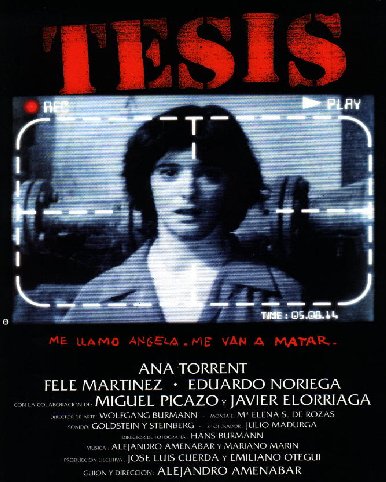 A man jumps in front of a train and commits suicide, forcing everyone to exit and walk past the bloody scene in a tunnel. Among the commuters is Angela (Ana Torrent), a college senior. She witnesses the curiosity of the passengers who eagerly try to get a glimpse of the morbid scene, and she, too, wanders closer in order to get a look. She decides to write her thesis paper on audiovisual violence and its relation to the masses. The interest comes from not only the scene on the train, but the roll of violence in the media. However, being new to the concept, and yet observing it all her life, she finds many obstacles in obtaining footage that is violent and/or pornographic. In short, she comes to the conclusion that she needs access to footage that is too crude for television.
A man jumps in front of a train and commits suicide, forcing everyone to exit and walk past the bloody scene in a tunnel. Among the commuters is Angela (Ana Torrent), a college senior. She witnesses the curiosity of the passengers who eagerly try to get a glimpse of the morbid scene, and she, too, wanders closer in order to get a look. She decides to write her thesis paper on audiovisual violence and its relation to the masses. The interest comes from not only the scene on the train, but the roll of violence in the media. However, being new to the concept, and yet observing it all her life, she finds many obstacles in obtaining footage that is violent and/or pornographic. In short, she comes to the conclusion that she needs access to footage that is too crude for television.
There are two sources that she expects to be quite lucrative in her quest for information. The first is her cinema professor, who is directing her thesis and has access to the school's film archives. The second proves to be more beneficial. Chema (Fele Martinez), a fellow student in her class, is rumored to be a sadist with a personal library of the kinds of films she needs to research. When she asks to see his collection, he is cold and unresponsive, but soon agrees to help her based on her good looks. What he shows her would be the equivalent to the shock value films, Faces of Death—film compilations that feature real accounts of torture, executions, etc. She's disturbed by the films, mainly because she realizes that there are people like Chema who are target audiences, and therefore the films have a sort of industry.







